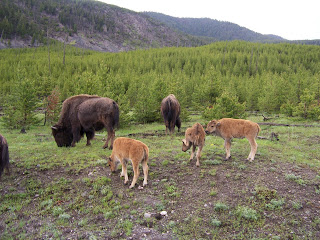There were so many amazing things about Yellowstone Nat'l Park - the wildlife, the scenery and the geysers - so much to share with you that I decided to make two posts for the park. The first part will be about the geysers-saving the wildlife and the scenery for the next post. Yellowstone National Park was established primarily because of its collection of geysers, hot springs, mudpots and steam vents. An article in the National Geographic said that half the geysers in the world are in Yellowstone. We saw steam vents almost immediately upon entering the park.
Some steam vents must have more water available to make steam - like this one below.
Old Faithful is probably the most famous of geysers in the park. This picture was taken about 30 minutes before its eruption.
More and more steam is building up. Geysers are hot springs with a narrow opening. Because of the intense heat, pressure builds up until the water rises eventually overflowing.
Here is a sequence of pictures when Old Faithful was at the height of its eruption the day we saw it.
A pamphlet about the geysers said Old Faithful erupts more frequently than any other of the big geysers although it is not the largest or most regular geyser in the park. 





This area was called Roaring Mountain. This was a very large area of steam vents. Because there was very little water available, the steam is almost gone by the time it reaches the surface. If you listen, you can hear a hissing noise from the steam.
The Mammoth Hot Springs area was so fascinating. The water from the hot springs rises through the limestone and creates amazing rock formations. Because the water continually flows, the rock formations can change frequently.
There was a lot of flowing water and a some steam but there was also some pools.
These mineral deposits were strangely shaped and colored.
It seemed like we were in another world.
As the water and minerals flowed over the side of the mountain, it created these awesome looking terraces.
This is a view of the side of the mountain below Mammoth Hot Springs from the road below it.
One day we visited the West Thumb Geyser Basin near Yellowstone Lake which you can see in the background of this picture.
It was interesting to find out that the color of these pools is determined by the thermophiles (heat-loving microorganisms) that grow in them.
The pool below is called Black Pool. We wondered why it was called that because it didn't appear black. We found out that at one time the water temperature was lower. The lower temperature allowed dark thermophiles to grow in the pool causing it to appear black. The water temperature has since increased and changed the kind of microorganisms.
The rock formation in the Black Pool made it seem to have two separate areas.
We are enjoying the sunshine and a little breeze.
One of the pools in the West Thumb Geyser are was called Seismograph Pool. No one knows why but it is thought the pool was renamed after the 1959 Hedgen Lake (7.5) earthquake just to recognize that the quake had happened.
The steam from these pools indicate how hot the water is but the Seismograph Pool was one of the few that had a sign posting the average temperature.
There a lot of cones created by the mineral deposits within the steam vents.
Some cones look like an open vent but some, like the one below, are filled to the brim with water.
This cone, the Fishing Cone, is currently under water. During the spring and early summer, the lake water levels rise from melting snow and cover the vent. When exposed, the temperature of the cone's water averages 199 degrees F.
These geysers are called the Lakeshore Geyser. They are both underwater and sometimes the smaller one is not exposed until mid to late August.
There are several places in the park that you can see mudpots. This one is called the Thumb Paint Pots. The water in the mudpots look like wet clay mud. Seems this is caused by the acidity of the water in them.
When this geyser was named, Percolating Spring bubbled vigorously like a coffee pot. It was so weird to see boiling water in a pool.
We are currently in Baker City, OR, visiting family - Bill's sister, Glenyth, her children and grandchildren. We plan to arrive home on Sunday, June 27th. After we get home, there will be another post for this trip about traveling in MT, ID and OR.



































































